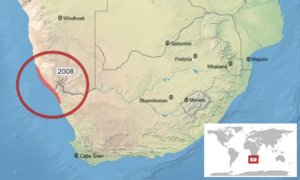Desert rain frog facts for kids
Quick facts for kids Desert rain frog |
|
|---|---|
| Conservation status | |
| Scientific classification | |
 |
The desert rain frog (Breviceps macrops) is a special type of frog found in Namibia and South Africa. It's also known as the web-footed rain frog or Boulenger's short-headed frog. These unique frogs live in a narrow strip of sandy land right next to the ocean. This area has loose sand, strong winds, and very little rain. Even though it's dry, they manage to survive! Sadly, their home is shrinking because of things like mining and tourism.
Contents
What Does the Desert Rain Frog Look Like?
The desert rain frog is a plump little frog. It has big, bulging eyes and a short snout. Its legs are short, and its feet are shaped like spades, perfect for digging. It also has webbed toes.
These frogs are usually between 4 and 6 centimeters (about 1.5 to 2.5 inches) long. Their skin is yellowish-brown, and sand often sticks to them. This sand helps them blend in with their surroundings. You can even see some of their insides through a clear patch of skin on their belly!
Unlike most frogs, desert rain frogs don't have a tadpole stage. They hatch directly from eggs as tiny froglets. Because of their stout bodies and small legs, they can't hop or leap. Instead, they walk across the sand. It's also unusual for a frog, but they don't need open water to live.
Where Do Desert Rain Frogs Live?
Desert rain frogs live in a small strip of land. This area is about 10 kilometers (6 miles) wide. It stretches along the coast of Namibia and South Africa. This sandy area gets a lot of fog, which brings moisture to an otherwise very dry place. A little rain falls during the winter months of June and July.
Their home is a unique place with sandy shores and dunes. It's one of the few spots on Earth where you can find these frogs. The climate is dry, but the frogs are well-suited to it. They can survive dry times by burrowing underground. They can also soak up water through their skin. The plants in their habitat are xerophytic (meaning they are adapted to dry places). In spring, many different flowers bloom here. The fog is very important because it gives them the moisture they need.
How Do Desert Rain Frogs Reproduce?
The breeding season for desert rain frogs is from June to October. During this time, male frogs come out of their burrows at night. They make a special squeaking sound to call to females. If a female likes a male's call, she will go to him. They mate underground.
After mating, the female lays a clutch of eggs. She can lay anywhere from 12 to 40 eggs. These frogs are "terrestrial breeders," which means their eggs develop underground in a burrow. One of the adult frogs usually stays near the nest. The eggs hatch into froglets that are already fully formed. They don't go through a free-swimming tadpole stage like many other frogs. These tiny froglets can move and hunt for insects on their own right away.
What Do Desert Rain Frogs Do?
Desert rain frogs are nocturnal, meaning they are active at night. During the day, they dig burrows about 10 to 20 centimeters (4 to 8 inches) deep. This is where the sand stays moist. They come out on both foggy and clear nights. You can often see their unique footprints on the sand dunes.
They are thought to eat moths, beetles, and insect larvae. They also eat ants. In the morning, they dig back into the sand. You can tell if a frog has been there by the small pile of loose sand left behind. When threatened, they make a high-pitched squeaking sound. The male's croaking sound is also very high-pitched.
Researchers have found that these frogs are calm when handled. They might also be territorial, meaning they protect their space from other frogs of the same kind.
Are Desert Rain Frogs in Danger?
The total area where desert rain frogs live is quite small. It's less than 2,000 square kilometers (about 770 square miles). Their habitat is also broken up into smaller pieces. In the past, the number of these frogs was going down. Now, we don't know if their population is still decreasing or not.
They are threatened by habitat loss. This is caused by open-pit diamond mining and building new roads. More human settlements also reduce their living space. Luckily, open-pit diamond mining has stopped in South Africa recently. Mining companies have tried to restore the frogs' habitat. This could mean the frogs are no longer as threatened. However, there's no clear proof yet that the frogs have moved back into these restored areas.


